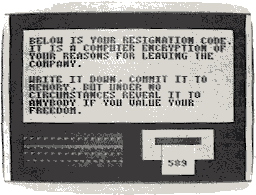A top-level British secret agent wants "out." Slamming his resignation onto the Company desk, he streaks back to his flat in a homebuilt Lotus 7, intending to pack his suitcase and escape to a quiet vacation in the sun. Then he hears the hiss of gas and, fighting against it, slips unconscious to the floor.
Waking, the agent looks around at his familiar bedroom. Was it a dream? He opens the window curtains and stares with astonishment at a baroque landscape of candy-colored Italian cottages. This isn't London!
So began The Prisoner, the unforgettable 1968 television series starring Patrick McGoohan that became a legend among fantasy/science fiction addicts. Inhabitants of the mysterious "Village" in which McGoohan's character found himself were identified only by number. Some were prisoners, others not; there was no way of knowing if an inmate was a former agent or a "custodian" who, using various psychological tricks, would persuade you into revealing "information" (the reason for the resignation?).

A few years ago, I made a pilgrimage to Portmeirion, the village in North Wales where the series had actually been filmed. As I walked the little streets, I could almost hear the ghostly Muzak playing, and I felt certain that, if I turned the next corner quickly enough, I would see a golf cart ahead of me. The only souvenir I have of that first visit is a paperback copy of The Prisoner by Thomas Disch. But I recently returned to the Village through the keyboard of my Atari.
Edu-Ware Service's new Prisoner II is an animated graphics adventure that recreates the Village (although they have rebuilt it as an "Island") and populates it with electronic frustrations no less sophisticated than the original. The packaging describes the product as a "Science Fiction Nightmare," but that description doesn't nearly do it justice.
Prisoner comes with a confidential dossier which outlines the problems you will face. After loading one of the two disks in the set, I was given a three-digit code which, I was told, was an encrypted reason for my resignation. I then found myself at an Airport, where I attempted to take a flight to Tokyo, or Honolulu, or anywhere but I found myself on a one-way trip to the Island.
After navigating an invisible maze, I entered the Village with an invitation to visit "The Caretaker" at my earliest convenience. His house wasn't hard to locate, but the door was locked. Other buildings with obscure purposes were easier to enter. An occasional step in the wrong direction sent me back to the maze with all the passages rearranged! Climbing the fence that surrounds the Island alerted an electronic watchdog called Pax, which also sent me back to the maze.
I was able to contact an underground organization called The Brotherhood; they assured me that, if I satisfied them of my integrity, they would help me to escape. But can I trust them? If I reveal my resignation code I will lose, but at times the pressure is so great that it would almost be a pleasure to submit.
The screen of Prisoner II consists of one line for text entry, another for the computer's response and a high-resolution display of your current location. Sounds, colors, animation and an (at times) intentionally unresponsive keyboard combine to raise your frustration level as you move around the Island. The interiors of buildings often change when you return to them; the standard adventure trick of "save the game and see what happens" just doesn't work here! You can record your current score and possessions using the STASIS command - which may or may not be available, depending on your location. When you reboot, you will be dumped back into the invisible maze. If you want a fresh start, perhaps to let a friend play, you must (unfortunately) give up by revealing your resignation code. This results in a humorous response and resets your environment.
The Prisoner II disks are copy-protected, so you cannot back them up. This is always a nuisance, especially in this case, where you can't write-protect the disk if you want to save your status. The program also requires you to swap disks from time to time; there is no support for multiple-drive play. I wonder how many times I can swap my master disks before they become unreadable? The only fault I could find in the documentation was that the program should be booted from Disk #1, not Disk #2 as stated.
Prisoner II is a superb package (I dare not call it a "game") that should provide weeks of entertainment. It goes far beyond the traditional "collect the right combination of treasures" adventure, and includes some diabolical arcade-like sequences to frus- trate you even more. I'm told that it is possible to escape from the Island. If you succeed, you will never forget it.
Be seeing you.